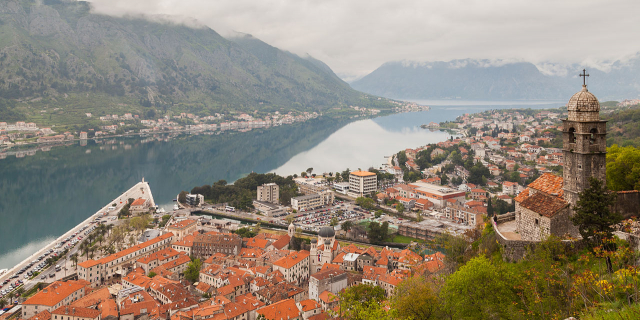Fort Vrmac
Fort Vrmac (Montenegrin: Tvrđava Vrmac/Тврђава Врмац, German: Werk Vermac) is a former fortification of the Austro-Hungarian Empire located on the southern end of the Vrmac ridge near Tivat in Montenegro. Established in 1860, the present structure was built between 1894 and 1897, and saw action during the First World War, when it was heavily bombarded by the Montenegrins. It was repaired and disarmed before the end of the war and was abandoned after a period of occupation by Yugoslav troops. Today it is one of the best preserved Austro-Hungarian fortifications in the Bay of Kotor area.
A fort was built on Vrmac as early as 1860, but it played only a minor part in the military actions of 1869 and 1882. The Krivošije rebellions prompted a decision by the Austro-Hungarian Reichsbefestigungskommission (State Fortification Commission) to replace it with a more advanced fortress. Constructed between 1894 and 1897, it was armed with eight 12 cm (4.7 in) minimum charter M80/85 mortars and four 10 cm (3.9 in) PH M05 guns, plus 12 gun carriages. It was initially designed to be able to accommodate four field guns erected on the roof, to be used for close defence. This unusual feature was removed in the 1906-7 strengthening of the fortress, following which it was redesignated as being purely for long-ranged artillery.[1]



By the outbreak of the First World War it was the most modern fortress in the vicinity of the naval base at Kotor and was the centre of the Austro-Hungarian Third Military District's defences. However, it was regarded as outdated by this point and a new bomb-proof fortress was envisaged on Hoher Vrmac (Sveti Ilija), the highest point on the ridge, about 1.6 km (0.99 mi) to the north. The war made such an undertaking impossible and the five officers and 177 men stationed at Vrmac found themselves the target of heavy bombardments from Montenegrin territory, from weapons of up to 24 cm (9.4 in) calibre. The fortress was heavily damaged but after the Austrians seized Lovćen in the spring of 1916 and drove the Montenegrins out of artillery range, the damage was fully repaired. Its guns were removed and reused elsewhere.[1]
After the collapse of the Austro-Hungarian Empire at the end of the war, the Bay of Kotor became part of the territory of Yugoslavia. Fort Vrmac was occupied for some years by the Royal Yugoslav Army before being abandoned. At some point during the Yugoslav tenure, one of the casemates was painted with icons depicting figures from Eastern Orthodox Christianity. The fortress remains in an abandoned condition; it is well-preserved overall and is the best-preserved of the fortifications on Vrmac. It can be visited by the public, though care needs to be taken, as there are open pits and holes in the floors.[1][2]































Add new comment